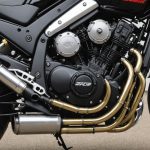Overview of UK Emissions Regulations
The United Kingdom has implemented comprehensive emissions regulations to mitigate environmental impact from vehicles, including sport bikes. These regulations are part of the UK’s commitment to reducing air pollution and carbon emissions in line with broader environmental standards. Sport bikes, known for their performance capabilities, must adhere to these strict criteria to ensure they contribute to a cleaner environment.
In particular, sport bikes are subject to specific emissions standards that dictate permissible levels of pollutants such as nitrogen oxides (NOx), hydrocarbons, and carbon monoxide. Compliance is crucial for both manufacturers and owners. Manufacturers must ensure that new sport bikes meet these criteria during the design and production phases. For owners, maintaining compliance can involve regular maintenance checks and possibly retrofitting older bikes to align with current standards.
In the same genre : Discover top gear to elevate your cycling experience online
The push for compliance underscores the importance of embracing more environmentally friendly technologies and materials in the production of sport bikes. This includes investing in innovations like advanced exhaust systems and more efficient engines. Ultimately, these regulations aim to balance the thrill of sport biking with necessary environmental responsibilities, ensuring sustainability for future generations.
Compliance Processes for Sport Bikes
Ensuring compliance is essential for maintaining both safety and legality when it comes to sport bikes. Understanding the legal requirements and associated processes can be daunting, but it is a necessary step.
Also read : Essential tips for optimizing sport bike suspension: enhancing passenger comfort on british roads
Steps to Achieve Compliance
To achieve compliance, several steps need to be followed. These include obtaining the required documentation and certifications, which are crucial for validating that all aspects of the bike meet legal standards. The application process involves submitting these documents to relevant authorities to verify compliance. Once accepted, follow-up procedures ensure continual adherence to regulations, addressing any emerging issues promptly.
Legal Requirements for Modifications
Sport bikes often undergo modifications, but it’s vital to consider the legal requirements surrounding these changes. Regulations restrict certain aftermarket upgrades to maintain safety and minimise environmental impact. Different engine types might have specific compliance factors, so it’s important to verify these before undertaking modifications. It’s also worth noting that certain upgrades can impact both performance and emissions, influencing the overall compliance status of the vehicle.
Cost and Time Involved in Compliance
Compliance processes come with both cost and time considerations. Estimated costs can vary widely depending on the nature of modifications and the bike itself. Typically, the timeline for compliance can extend over several weeks. Factors influencing costs and time include the complexity of modifications and the efficiency of processing by authorities. The goal is to ensure safety and reliability while conforming to regulations.
Technical Standards and Testing Procedures
Understanding the technical standards and testing procedures for sport bike emissions is crucial for performance and environmental compliance. These standards define the permissible levels of pollutants a sport bike can emit. Compliance with these standards ensures that manufacturers produce bikes that balance power with environmental responsibility.
Key Technical Standards
Technical standards vary by region but generally focus on controlling harmful emissions like carbon monoxide, hydrocarbons, and nitrogen oxides. These standards are pivotal in reducing air pollution and safeguarding public health.
Emissions Testing Methodologies
Emissions testing involves specific methodologies, assessing a sport bike’s environmental impact. Testing generally occurs on a dynamometer, simulating a range of riding conditions to capture accurate emissions data. This allows manufacturers to refine engine performance while adhering to environmental regulations.
Importance of Regular Maintenance
Regular maintenance is vital for ensuring ongoing emissions compliance. Factors like engine tuning, exhaust system integrity, and proper fuel quality all play roles in maintaining optimal emissions performance. Neglecting preventive measures can lead to deterioration in performance and increased emissions, undermining compliance with technical standards. Regular check-ups ensure that sport bikes deliver top performance while staying environmentally friendly.
Case Studies of Compliant Sport Bikes
Navigating through the intricacies of emissions regulations can be challenging for sport bike manufacturers. However, numerous success stories provide hope and insight. Case studies illuminate the journey of brands achieving compliance.
Manufacturer-Specific Compliance Examples
Manufacturers like Yamaha and Kawasaki have spearheaded exemplary strategies to align with environmental standards. Yamaha’s recent models, such as the YZF-R1, are renowned for meeting stringent emissions criteria, thanks to advancements in catalytic converters and electronic fuel injection systems. Kawasaki’s Ninja H2 series is lauded for not only meeting but exceeding these regulations through a combination of innovative engineering and robust testing protocols. These compliance examples illustrate the importance of adopting cutting-edge technology and sustainable practices.
Owner Experiences and Modifications
Sport bike owners have also been vital in addressing compliance at a grassroots level. Enthusiasts recount their experiences of modifying their bikes to meet emissions standards, often citing exhaust system adjustments and ECU reprogramming as effective solutions. Though challenges, such as maintaining performance levels post-modification, are prevalent, shared insights from owners may provide inspiration and guidance to others. Practical tips—like partnering with certified technicians—are central to successful compliance in these success stories.
Resources for Achieving Compliance
Navigating the landscape of emissions compliance can be daunting. Fortunately, a wealth of resources is available to help organisations and individuals stay informed and compliant. Key to achieving this is accessing the right educational tools.
Recommended Reading and Online Resources
To begin with, numerous online resources provide valuable insights and updates. Websites like the Environmental Agency offer comprehensive guides and updates on the latest emissions standards. For those keen on industry-specific details, sectoral publications and white papers are indispensable. They offer detailed analyses and case studies that can illuminate abstract compliance issues.
Organizations and Assistance
Various organizations and agencies stand ready to provide support. For instance, the Environmental Protection Association (EPA) frequently updates its database with practical guidelines and compliance checklists. Associating with compliance bodies and regulatory agencies can also help you receive timely alerts and expert advice, ensuring you remain proactive rather than reactive.
Workshops and Training Programs
Lastly, upcoming workshops and training programs are crucial for hands-on learning. Many institutions host these events, focusing on the latest strategies in emissions compliance. Participating not only enhances your knowledge but also helps network with other professionals facing similar challenges.











